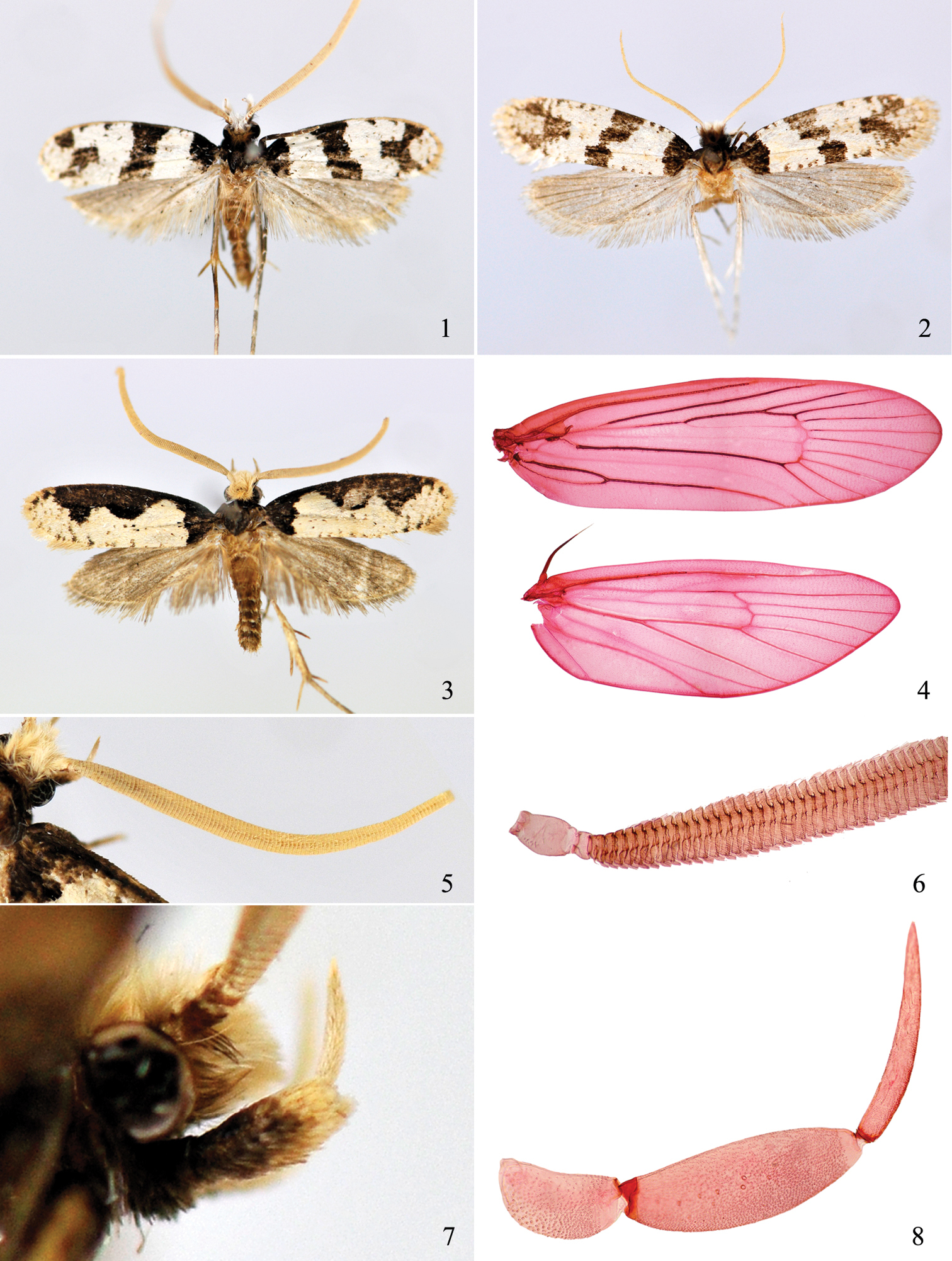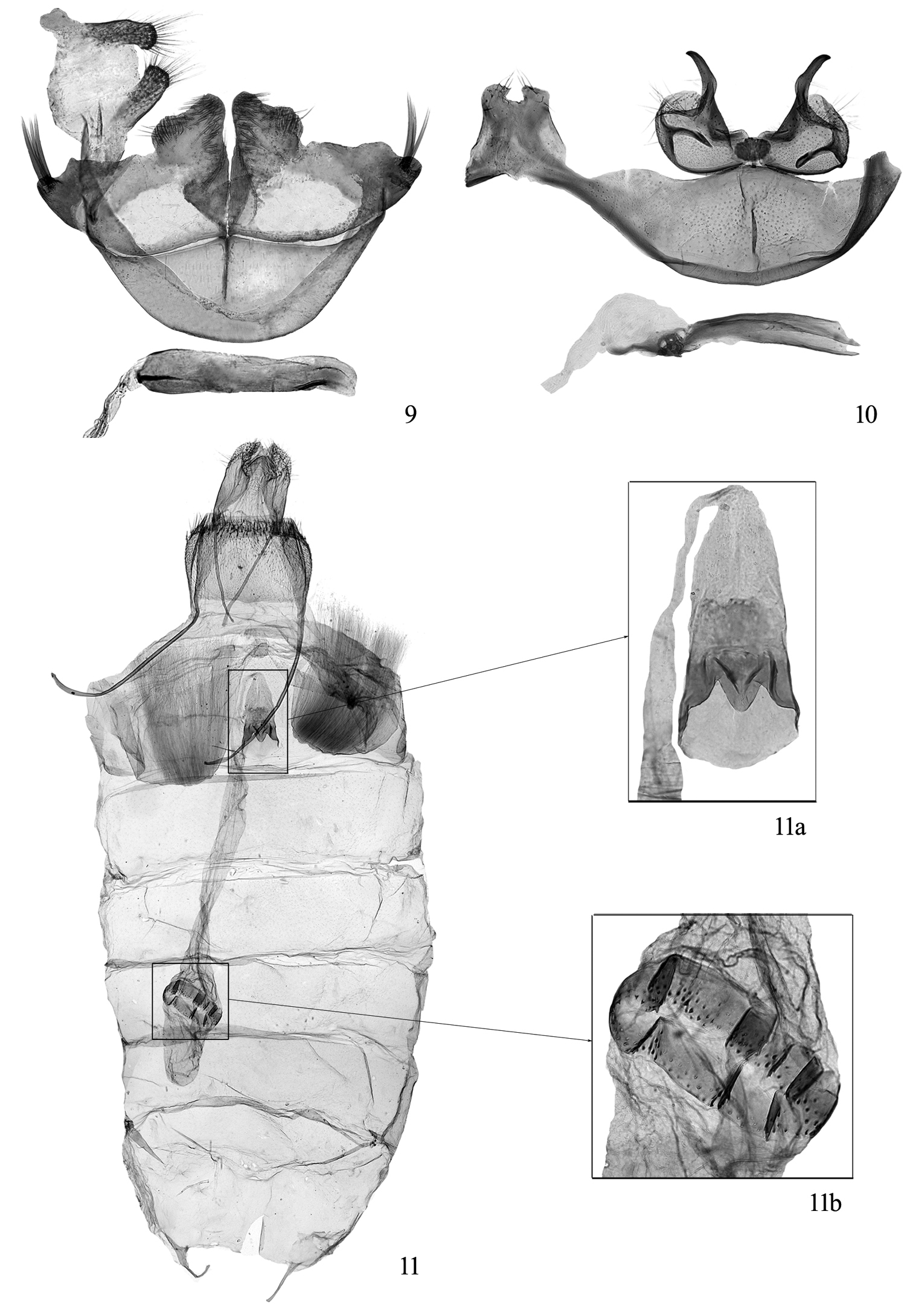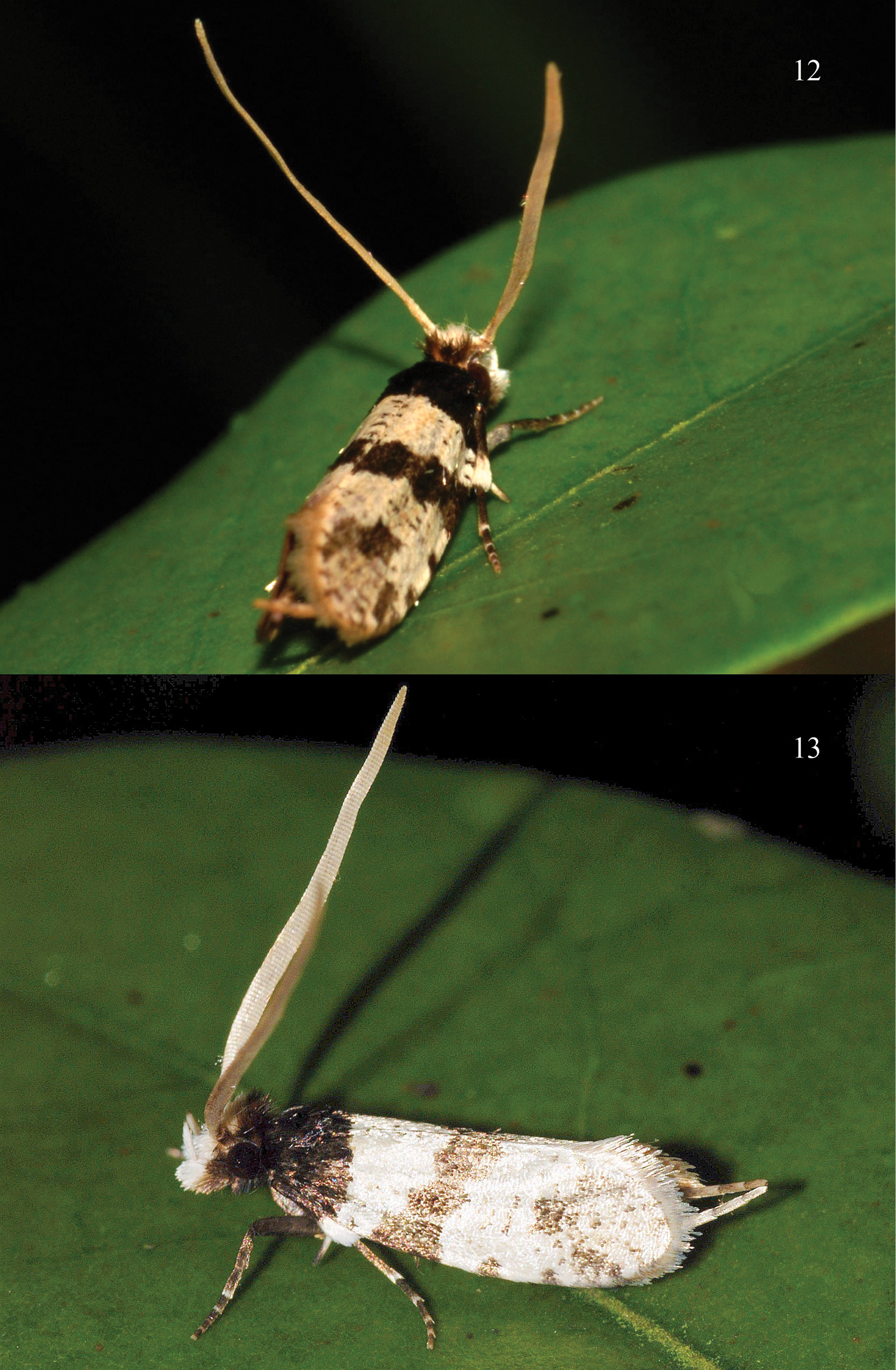






(C) 2012 Linlin Yang. This is an open access article distributed under the terms of the Creative Commons Attribution License 3.0 (CC-BY), which permits unrestricted use, distribution, and reproduction in any medium, provided the original author and source are credited.
For reference, use of the paginated PDF or printed version of this article is recommended.
The taxonomic study of the genus Thisizima Walker, 1864 is carried out in China. Thisizima subceratella sp. n. and Thisizima fasciaria sp. n. are described as new based on the specimens collected in Fujian, Hainan and Hong Kong. Detailed male and female genitalia are described for the first time for the genus. Photographs of adults and genital structures are provided. A checklist of all the described species is included.
Lepidoptera, Tineidae, Thisizima, new species, China
The genus Thisizima was established by
Specimens examined in this study were collected by light traps in Fujian, Hainan and Hong Kong. The type specimens are deposited in NKU and KFBG respectively.
Genitalia dissections were carried out following the methods described by
Thisizima ceratella Walker, 1864: 820, by monotypy.
Head with tufts of erect piliform scales. Antenna (Figs 5, 6) about 1.2× length of forewing in male, and 0.75× length in female; scape expanded, pecten with fewer than 15 bristles; flagellum compressed broadly and flatly, although considerably broader in male, with appressed scales, cilia not visible without removal of scales. Maxillary palpus rather reduced, minute, 1/3 length of first segment of labial palpus, 4-segmented, segmental ratio 2:1:1.5:1. Labial palpus (Figs 7, 8) rather long, almost 2.5× height of head, curved, ascending; segmental ratio 1:2:2; second segment with dense forwards projecting piliform scales, with 6−7 lateral bristles; third segment with appressed scales, slender and pointed, without vom Rath’s organ. Forewing (Fig. 4) with costa moderately arched, apex roundly obtuse, termen obliquely rounded; unicolored or bicolored; all veins separate, R1 from basal 1/4 of cell, R3 from upper angle, R5 to apex, M3 close to CuA1 at base, CuA1 from lower angle of cell, forked portion of A1+2 about 1/3 length of vein, trace of CuP weak, cell closed, with trace of chorda and M stem; retinaculum in male subcostal, elongately triangular, with broad base and curled apex. Hind wing (Fig. 4) with costa moderately arched, apex rounded, slightly pointed than forewing, termen more oblique than forewing; all veins present, Rs parallel to Sc+R1, CuA2 from middle of lower margin of cell, trace of CuP weak, cell closed, with weak trace of M stem; frenulum with one stout bristle, sharp toward apex, angled at basal one third in male; also one bristle in female, much slender and shorter than in male. Legs smoothly scaled, except hind tibia with moderately elongate scales; foretibial epiphysis absent, hind tarsus without spine; tibial spur pattern 0-2-4, mid leg with outer spur about half length of inner spur, hind leg with outer mid spur about 0.4× length of inner spur, outer proximal spur about 0.6× length of inner spur.
Male genitalia. Corema absent in eighth segment. Vinculum rather broad, forming a strongly sclerotized cylinder with ill-defined tegumen. Uncus bilobate. Gnathos and subscaphium absent. Valva complex, base broad, scattered with strong hairs on outer surface; apodeme short, digitate. Transtilla absent.
Female genitalia. Corethrogyne present in seventh segment, invaginated into three intersegmental pouches. Ovipositor short and broad; papillae anales large, setose, sclerotized laterally; with one membranous dorsal sac and three ventral sacs between papillae anales, flower-like on top view. Apophyses short, apophysis posterior about 0.4× length of apophysis anterior. Ostium located on seventh sternite. Antrum distinct, anatropous.
The elongate, curved, ascending labial palpus of Thisizima is quite similar to that of Tinissa Walker, 1864 in Scardiinae, to that of Euplocamus Latreille, 1809 and Psecadioides Butler, 1881 in Euplocaminae. Thisizima can be distinguished by the antenna with flagellum strongly flattened in both sexes; while the antenna is filiform in Tinissa, and bipectinate in male and filiform in female in Euplocaminae. Besides, R4 and R5 on the forewing are separated in Thisizima, but stalked in the last three genera. The corethrogyne of Thisizima in female is invaginated into three intersegmental pouches that can also be found in Perissomasticinae, but its other female characters are quite different from those of the members in Perissomasticinae.
Little is known about its biology. The living habitat is shown in figures 12 and 13.
China (Fujian, Hainan, Hong Kong); Burma, Thailand, West Malaysia, India, Sikkim, Bhutan, Sri Lanka, the Andaman Islands and the Anambas Islands.
Thisizima was placed in Tineidae since its establishment. The genus belongs to Tineidae without doubt, represented by the head with erect piliform scales, the subovate forewing with R4 terminating on costa, the male retinaculum arising from Sc, and the female abdomen with corethrogyne in the seventh segment. However, its subfamily position has not been assigned due to some characters that indicate the uniqueness of this genus: the strongly flattened antenna, the rather reduced maxillary palpus, the absence of foretibial epiphysis and the position of ostium. The shape of the labial palpus may suggest its affiliation with Scardiinae and Euplocaminae; the corethrogyne in female may suggest its affiliation with Perissomasticinae. The status of Thisizima might be settled with further work on its morphology and biology.
1. Thisizima antiphanes Meyrick, 1894
Thisizima antiphanes Meyrick, 1894: 27.
Type locality: Burma.
Depository of type: BMNH (HT).
Distribution: Burma and Thailand.
2. Thisizima bovina Meyrick, 1928
Thisizima bovina Meyrick, 1928: 428.
Type locality: Andaman Islands.
Depository of type: Unknown.
Distribution: Andaman Islands.
3. Thisizima bubalopa Meyrick, 1911
Thisizima bubalopa Meyrick, 1911: 125.
Type locality: Sri Lanka (Peradeniya); India (Nilgiris).
Depository of types: BMNH (ST).
Distribution: Sri Lanka and India.
4. Thisizima ceratella Walker, 1864
Thisizima ceratella Walker, 1864: 820.
Type locality: India.
Depository of type: BMNH (HT).
Distribution: India, Burma, Thailand, West Malaysia and Anambas Islands.
5. Thisizima fasciaria sp. n.
Type locality: China (Fujian).
Depository of type: NKU (HT & PT), KFBG (PT).
Distribution: China (Fujian, Hong Kong).
6. Thisizima sedilis Meyrick, 1907
Thisizima sedilis Meyrick, 1907: 989.
Type locality: Bhutan; Sikkim.
Depository of type: IMK (ST).
Distribution: Bhutan, Sikkim, Burma and Thailand.
7. Thisizima subceratella sp. n.
Type locality: China (Fujian).
Depository of type: NKU (HT & PT), KFBG (PT).
Distribution: China (Fujian, Hainan, Hong Kong).
urn:lsid:zoobank.org:act:A0755544-7CF8-4F5F-AE68-396A337FF41B
http://species-id.net/wiki/Thisizima_fasciaria
Figs 1, 2, 10−13CHINA, Holotype ♂, Fujian Province: Mt. Tianzhu (24°35'N, 117°55'E), Xiamen City, 220 m, 14.ix.2010, leg. Yinghui Sun & Jing Zhang (NKU).
Paratypes: 2 ♂, 15, 19.viii.2010, leg. Bingbing Hu & Jing Zhang, same locality as holotype, genitalia slide No. YLL11172 (NKU). Hong Kong: 1 ♀, Kadoorie Agricultural Research Centre (22°25'N, 114°06'E), 210 m, 20.iv.2007, leg. Houhun Li et al. (NKU), genitalia slide No. YLL11165; 1 ♂, Kadoorie Agricultural Research Centre, 210 m, 20.ix.2009, leg. Houhun Li et al. (NKU); 1 ♂, Kadoorie Farm and Botanic Garden (22°25'N, 114°07'E), 315−575 m, 26.ix.2009, leg. Houhun Li et al. (NKU); 1 ♀, Kadoorie Agricultural Research Centre, Shek Kong, N.T., UTM: 50Q KV 030833, 28.iv.1997, 125W MBF, leg. R.C. Kendrick, genitalia slide No. YLL11171 (KFBG); 1 ♂, Kadoorie Agricultural Research Centre, Shek Kong, N.T., UTM: 50Q KK 029832, alt. 200 m, 6.v.1998, 125 W MBF, leg. R.C. Kendrick (KFBG); 1 ♂, Kadoorie Agricultural Research Centre, Shek Kong, N.T., UTM: 50Q KK 029832, alt. 200 m, 2.iv.1999, 125 W MBF, leg. R.C. Kendrick (KFBG).
Imago (Figs 1, 2): Wingspan 13.0−15.0 mm in male, 17 mm in female. Vertex cupreous brown on posterior half, snow white on anterior half; frons snow white, with fine black scales on outer side before eyes. Antenna about 1.2× length of forewing in male, and 0.75× length in female including fringe; scape yellowish white above, brown mixed with black scales below, pecten with 10−15 black bristles; flagellum yellow, compressed broadly and flatly. Labial palpus snow white, first segment dark cupreous brown on outer surface, second segment cupreous brown on outer surface of basal half, with sparse black lateral bristles. Thorax and tegula black. Forewing index about 0.32; ground color bright white; a black triangular patch from costal margin to dorsum on basal 1/6; an oblique, black fascia from basal 1/3 to just before middle of dorsum, slightly narrowed medially, sinuate along both margins; a rectangular black patch from outer margin of cell to distal 1/6 of forewing, confluent with two black subtriangular patches from costa and termen before apex respectively, forming a broad Y-shaped pattern; two black costal spots between oblique fascia and Y-shaped pattern; termen and dorsum scattered with faint dark brown dots, dim in some specimens; fringe yellowish brown. Hindwing index 0.35; light grayish brown; fringe gray; frenulum with one stout bristle in male, one much slender and shorter bristle in female. Fore leg black; mid leg black, with snow white fine scales at apex of tibia, tarsus yellowish brown on ventral surface, with white at apex of each segment on dorsal surface, spurs dark brown; hind leg and spurs yellowish brown, apex of tibia and each segment of tarsus with white scales dorsally.
Morphology of Thisizima spp. 1 Thisizima fasciaria sp. n., holotype 2 Thisizima fasciaria sp. n., paratype 3 Thisizima subceratella sp. n., holotype 4−8 detailed structures of Thisizima subceratella sp. n., paratypes: 4 vein 5, 6 antenna 7, 8 labial palpus (4, 6, 8 slide No. NKYLL010) (1, 3−8 ♂, 2 ♀).
Male genitalia (Fig. 10). Vinculum convex anteriorly in arch, slightly convex at middle on posterior margin. Uncus sclerotized, trapezoidal, semicircularly concave at middle on posterior margin; uncus lobes short, setose. Valva rounded in basal half, horn-shaped and curved outwardly in distal half, setose on outer surface. Juxta small, subovate. Aedeagus slightly curved ventrad, with a pair of blade-shaped lateral sclerites connected by membrane dorsally and opened ventrally, apex sharp obliquely; cornutus absent.
Female genitalia (Fig. 11). Seventh tergite short, membranous except heavily sclerotized anteriorly; sternite slightly sclerotized, 0.2× as long as broad, tapered posteriorly, produced to a slender, elongate plate at middle. Eighth tergite rectangular, with dense, minute spinules, with short spines along posterior margin; sternite rectangular, with dome-like membranous section medially, scattered with short spinules, sclerotized section with dense short spinules. Ostium at anterior 1/3 of seventh sternite, rounded. Antrum (Fig. 11a) heavily sclerotized, funnel-shaped, with a more sclerotized pouch anteriorly on ventral surface. Ductus bursae about 1.4 × length of corpus bursae, posterior 1/6 slender, anterior 5/6 broadened; inception of ductus seminalis at posterior 1/6 of ductus bursae. Corpus bursae elongate oval, with a broad ring-shaped, punctate signum at posterior 1/3 (Fig. 11b).
Genitalia of Thisizima spp. 9 male genitalia of Thisizima subceratella sp. n., paratype, slide No. NKYLL010 10−11 Thisizima fasciariasp. n., paratypes: 10 male genitalia, slide No. YLL11172 11 female genitalia (11a. antrum; 11b. signum), slide No. YLL11156.
The bold, bicolored forewing pattern of the new species is diagnostic: ground color bright white with a triangular black patch at base, an oblique, black fascia near middle and a somewhat Y-shaped black patch near apex. There are four other species with bicolored forewing pattern: Thisizima antiphanes has a white basal band and an apical dot, Thisizima sedilis has a large rounded-triangular costal blotch, Thisizima ceratella has a broad irregular costal stripe broadly confluent with basal patch on anterior margin, and Thisizima subceratella sp. n.has a broad black costal blotch narrowly confluent with basal patch on anterior margin.
The living habitat is shown in figures 12 and 13.
Adults of Thisizima fasciaria sp. n. in repose. 12 Shan Liu, Sai Kung, Hong Kong, 9.iv.2010, photographed by R.C. Kendrick 13 Hong Kong, photographed by R.C. Kendrick.
China (Fujian, Hong Kong).
This specific name is derived from the Latin fasciarius, meaning fascia, referring to the oblique, black fascia near middle of forewing.
urn:lsid:zoobank.org:act:FA0F81DD-9A18-4261-BB92-F89F9681B288
http://species-id.net/wiki/Thisizima_subceratella
Figs 3−9CHINA, Holotype ♂, Fujian Province: Mt. Tianzhu (24°35'N, 117°55'E), Xiamen City, 220 m, 12.ix.2010, leg. Yinghui Sun & Jing Zhang (NKU).
Paratypes: 2 ♂, 30.viii, 19.ix.2010, other same data as holotype, genitalia slide No. NKYLL010 (NKU). Hainan Province: 1 ♂, Mt. Wuzhi (18°31'E, 109°24'E), 700 m, 19.v.2007, leg. Zhiwei Zhang & Weichun Li (NKU). Hong Kong: 2 ♂, Kadoorie Agricultural Research Centre (22°25'N, 114°06'E), Shek Kong, N.T., UTM: 50Q KV 030833, 125 W MBF, 28.iv.1997, leg. R.C. Kendrick (KFBG).
Imago (Figs 3−8). Wingspan 18.5−20.5 mm in male. Vertex and frons yellowish white, tinged with brown around eyes. Antenna about 1.2× length of forewing including fringe; scape yellowish white above, scattered with brown scales below, pecten with 8−12 black bristles; flagellum ochreous yellow, compressed broadly and flatly. Labial palpus yellowish white, first segment black on outer surface, second segment black on outer surface of basal 2/3, with sparse black lateral bristles. Thorax black, tegula black on anterior half and dark cupreous brown on posterior half. Forewing index about 0.3; ground color creamy white, with scattered dark brown scales on distal 1/4; a triangular black patch on basal 1/5, broader at costa, sinuate along outer margin; a broad black costal blotch narrowly confluent with basal patch on anterior margin, curved in W shape on posterior margin, its basal half apically rounded and reaching half width, distal half triangularly crossing midwing; two small indistinct spots along costa before apex; termen and dorsum scattered with faint dark brown dots; fringe light yellowish brown. Hind wing index 0.38; cupreous brown; fringe grayish brown; frenulum one stout bristle. Fore leg black except distal half of coxa yellowish brown on ventral surface; mid leg black except tarsus yellowish brown on ventral surface, spurs dark brown; hind leg yellowish brown mixed with black scales.
Male genitalia (Fig. 9). Vinculum convex anteriorly in arch, slightly convex at middle on posterior margin; with a longitudinal suture in middle posteriorly, 0.5× length of vinculum. Uncus membranous, trapezoidal; uncus lobes digitate, slightly sclerotized, with elongate setae on ventral surface. Valva with base broad and gently arched, connected ventrally at base by a sclerotized, somewhat funnel-shaped plate on inner surface; basal 2/3 membranous and inverted fan-shaped, scattered with strong hairs on outer surface; apex as wide as base, heavily sclerotized, sinuate, dorsoapically with a tuft of 3−4 strong spines, ventroapically convex, with dense, stout spines on outer surface. Juxta membranous. Aedeagus membranous dorsally, sclerotized ventrally, with a shallow keel at base; cornutus absent.
Female. Unknown.
The new species is quite similar to Thisizima ceratella, but can be separated by the forewing having a broad blackish costal blotch narrowly confluent with the basal patch on anterior margin, curved in W-shape on posterior margin; while Thisizima ceratella has an irregular cupreous black costal stripe broadly confluent with the basal patch on anterior margin, curved outward before middle on posterior margin.
China (Fujian, Hainan, Hong Kong).
The specific name is derived from the Latin prefix sub-, meaning similar, and another specific name ceratella, referring to the similarities of the two species.
K. Tuck (BMNH) assisted us to check the identity of Thisizima ceratella. Unfortunately, the holotype has lost its hindwings and abdomen. The late G. Robinson had therefore dissected a male specimen identified as ceratella in the Meyrick collection, collected in Koni, Burma. Tuck kindly compared our illustrations of Thisizima subceratella sp. n.with Robinson’s slide BMNH Microlep. No. 27736. He noticed a small but distinct difference in the shape of the valva: in Robinson’s dissection the valva is slightly larger and therefore extends further laterally and has five strong spines, whereas our illustration shows a relatively short valva with only 3−4 spines on each.
Furthermore, the adult photograph of Thisizima ceratella given by
There are many tineid species showing small differences in genitalia, but they can usually be recognized by the external morphology, such as forewing pattern and venation (eg. species of Monopis Hübner). The forewing pattern in the new species is quite different from that of Thisizima ceratella, and the shape of the valva does have small but distinct difference between the two species, which we regard as sufficient evidence that this is a good species.
We express our thanks to Mr. Kevin Tuck (BMNH, London) for checking the holotype of Thisizimaceratella, to anonymous referees for their helpful comments and precious references, and to those who took part in the field work. This research was supported by the National Natural Science Foundation of China (No. 30930014 & No. J1210005).


